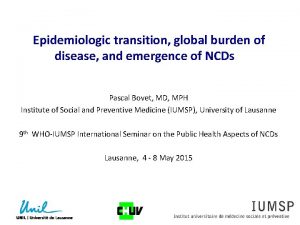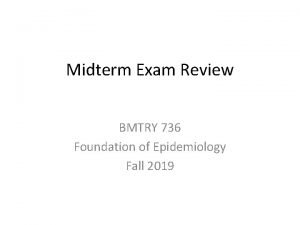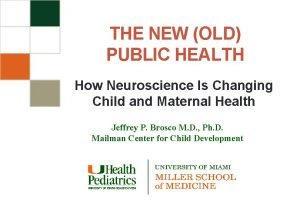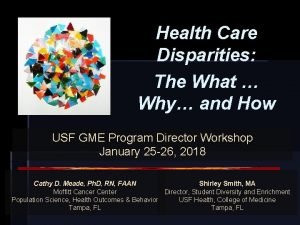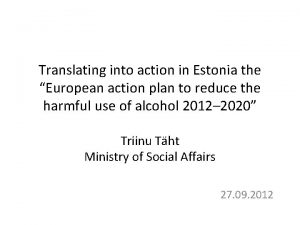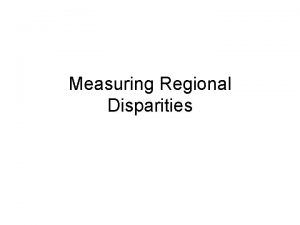Translating Epidemiologic Findings into Action to Eliminate Disparities













































- Slides: 45

Translating Epidemiologic Findings into Action to Eliminate Disparities A Sci. Metrika “Chalk Talk” Durham, NC, February 25, 2014 Victor J. Schoenbach, Ph. D. , go. unc. edu/vjs/ Department of Epidemiology and Minority Health Project UNC Gillings School of Global Public Health Marion E. Schoenbach (Enabler)

How soon is too soon? Not soon enough. Laboratory tests over the last few years have proven that babies who start drinking soda during that early formative period have a much higher chance of gaining acceptance and “fitting in” during those awkward pre-teen and teen years. So, do yourself a favor. Do your child a favor. Start them on a strict regimen of sodas and other sugary carbonated beverages right now, for a lifetime of guaranteed happiness. -Promotes Active Lifestyle! -Boosts Personality! -Gives body essential sugars!




Outline o The movement to eliminate health disparities o Strategic plans and progress o Translating epidemiologic knowledge into public health action on disparities o A broader perspective

Secretary’s Task Force on Black & Minority Health, 1985 o “Heckler Report” o Useful landmark o Minorities experience 60, 000 excess deaths o 8 main recommendations, including: outreach, cultural awareness, coordination, health care access, data, research

1990 s initiatives 1990 NIH Office of Minority Programs 1993 Health Revitalization Act, NIH ORMH 1997 Presidential apology for Tuskegee APHA/HHS Campaign to Eliminate Racial and Ethnic Health Disparities 2000 PL 106 -525: Minority Health & Health Disparities Research & Education Act

Trans-NIH strategy A primary goal of PL. 106 -525 - ensure that NIH health disparities research be an integrated and inclusive field of study, rather than an aggregate of independent research activities in separate research domains. 27 NIH institutes and centers developed strategic plans during 2002 -2006

IOM: Examining the NIH Health Disparities Research Plan (2006) o Conceptual issues o Need more attention to social determinants, … o Update strategic plans o Budget not allocated o More staffing o Need more trans-NIH coordination

Healthy People 2010 Final Review: Changes in health disparities “most of the population-based objectives (Healthy People 2010 Final Review) with data to measure disparities had no change in health disparities. ”

How Far Have We Come in Reducing Health Disparities Recurring themes from an April 8, 2010 Institute of Medicine workshop: o Health disparities are not going away o Economic hardship is an important contributor o Institutional racism and racial discrimination persist o Residential segregation, community environment o Low levels of awareness among general public o Policies of federal agencies besides those directly related to health o Community input/initiation is key o The Affordable Care Act should help

2012: How Far Have We Come in Reducing Health Disparities? Paula Braveman: o More and better research on social determinants, … o Intervention research o Translational research: How inform public? How get them to care? How create political will

A Tale of Two Disparities o Childhood immunization / measles elimination o HIV/AIDS

Childhood immunization / measles elimination Dual strategy: universal interventions + targeted interventions Gap in measles vaccine coverage narrowed from 15% (1985) to 6% (1992) to 2%. Risk ratio for disease among nonwhite children (vs. white) declined from 4 -7 to 4 to elimination of endemic disease Elimination of Measles and of Disparities in Measles Childhood Vaccine Coverage among Racial and Ethnic Minority Populations in the United States Sonja S. Hutchins, Ruth Jiles, Roger Bernier. JID 2004; 189: S 146 -S 152

Increase in vaccine coverage and reduction of disparity Elimination of Measles and of Disparities in Measles Childhood Vaccine Coverage among Racial and Ethnic Minority Populations in the United States Sonja S. Hutchins, Ruth Jiles, and Roger Bernier JID 2004(May 1); 189: S 146 -S 152

Maintenance of parity in measles vaccine Elimination of Measles and of Disparities in Measles Childhood Vaccine Coverage among Racial and Ethnic Minority Populations in the United States Sonja S. Hutchins, Ruth Jiles, and Roger Bernier JID 2004(May 1); 189: S 146 -S 152

Elimination of measles and disparity Elimination of Measles and of Disparities in Measles Childhood Vaccine Coverage among Racial and Ethnic Minority Populations in the United States Sonja S. Hutchins, Ruth Jiles, and Roger Bernier JID 2004(May 1); 189: S 146 -S 152

Endgame: HIV/AIDS in African Americans (PBS Frontline) 1983: The CDC begins tracking breakdown of HIV by race. 1985: First Black AIDS Organizations founded 1986: First Black AIDS Conference 1986: No one of color is invited to participate in the American Public Health Association’s first session on AIDS in October 2000: The CDC announces that black and Latino men now represent a majority of new AIDS cases among gay and bisexual men, exceeding their white counterparts. 2004: HIV Becomes Leading Cause of Death for Young Black Women 2008: CDC data shows that 1 in 16 black men will be diagnosed with HIV in their lifetime, as will 1 in 32 black women. 2009: Congress removes ban on federal funding for needleexchange programs; 2011: Congress reinstates ban. 2012: Black AIDS Institute Report “Exit Strategy: Ending the AIDS Epidemic in Black America”

A Tale of Two Disparities Childhood immunization HIV Magnitude of problem Embedded in socio-economic Availability of interventions Cost, cost-effectiveness Use existing health care infrastructure Neutral or favorable to commercial, religious, political interests Near-term, visible, marketable impact + + ++ +++ ++ ++ ?

NIH Health Disparities Strategic Research Plan and Budget, Fiscal Years 2009 -2013 o Health disparities persist and are seen across a broad spectrum of diseases and adverse outcomes. o Health disparities are a concern for the nation. o Health disparities are costly ~ 230 billion o Health disparities are “shaped by the interaction of … social, environmental, behavioral, and biological factors. ”

NIH Health Disparities Strategic Research Plan and Budget, Fiscal Years 2009 -2013 (con’t) o ~ $3 billion in FY 2010. o 67 pages of research on genetics and biological factors, behavioral and social sciences, clinical and translational research, comparative effectiveness research, social determinants of health, health services research, innovative health technologies

Can we centrally plan away health disparities? o All aspects of life affect health, and we don’t understand any aspect fully. o Actions have multiple causes and effects (direct vs. indirect, now vs. later, …). o Different people have different views and are affected differently. o We can’t all agree, and there is no one in charge.

Behavior is fundamental Health disparities arise from and are maintained by behavior: o o o Personal behavior Expressive behavior Professional behavior Economic behavior Political behavior What influences behavior? 24

Under the influence of hormones o “… hormones alter emotional states (such as fear), bias attention (for example, toward sexual stimuli), or change the pleasantness or aversiveness of stimuli (such as infant odors) to alter behavioral probabilities in ways that depend on prior experience. ” p 1146 o “The basic endocrine mechanisms and brain structures have been remarkably conserved in the course of evolution. . . ” (Elizabeth Adkins-Regan. Under the influence of hormones. Science 29 May 2009; 324: 1145. Review of Peter T. Ellison and Peter B. Gray, eds. Endocrinology of social relationships. Harvard, 2009) 25

Chronic stress restructures the brain o Habitual actions require less mental effort than actions selected to achieve an outcome but must be inhibited if the situation changes. o Rats subjected to chronic stress became less sensitive to changes in outcomes. o Chronic stress caused structural changes in the brain that may bias toward habit and dysfunctional decision-making. (Eduardo Dias-Ferreira et al. , Chronic stress causes frontostriatal reorganization and affects decision-making. Science 31 July 2009; 325: p 621 -625) 26

Are we losing our smarts? “The results of this study show that long working hours may be one of the risk factors that have a negative effect on cognitive performance in middle age. ” 604 Long working hours and cognitive function: The Whitehall II Study. Marianna Virtanen et al. Am J Epidemiol 2009; 169: 596 -605

Contextual influences "In conclusion, Americans are exposed, via television, to nonverbal race bias, and such exposure can influence perceivers' race associations and selfreported racial attitudes. Nonverbal behavior that communicates favoritism of one race over another can be so subtle that even across a large number of exposures, perceivers are unable to consciously identify the nonverbal pattern. Yet despite (or perhaps because of) this subtlety, exposure to nonverbal race bias may transmit race bias to perceivers. " 1714 Max Weisbuch, Kristin Pauker, Nalini Ambady. The subtle transmission of race bias via televised nonverbal behavior. Science 18 Dec 2009; 326: 1711 -1714.

Can brain function be improved? o “Quiet time” programs have shown great promise in urban schools with typical problems. (“From time-out to quiet time: meditation comes to SF schools”) http: //kalwnews. org/audio/2011/02/10/time-out-quiettime-meditation-comes-sf-schools_836458. html (link) [5 min. ]

Can consciousness be improved?



THE 16 TH ANNUAL WILLIAM T. SMALL JR. KEYNOTE LECTURE DR. GAIL C. CHRISTOPHER, DN Keynote speaker Friday February 28, 2014 2: 00 pm – 3: 30 pm EST Register online: http: //minorityhealth. web. unc. edu/confer ence/keynote-webcast/

Thank you – let’s talk! o Your comments here o And here

Extra slides for the discussion

Propositions on human behavior: looking under the hood 1. Living systems are made up of fundamental building blocks (e. g. , quarks, electrons, protons, atoms, molecules) organized into organelles, cells, organs, etc.

Propositions 2. Living systems replicate, diversify, compete, cooperate, invade one another, incorporate one another, combine, and evolve into systems of increasing complexity.

Propositions 3. Complex living systems have nervous systems that can create the experiences of consciousness, memory, imagination, deductive logic, extrapolation, anticipation, prediction, and other mental functions.

Propositions 4. These mental functions are generated by the interactions of over 80 billion individual agents (neurons), in the context of other types of cells and the factors they secrete, as well as other internal and environmental chemicophysical influences.

Propositions 5. The resulting thoughts and actions, which are also influenced by perceptions and expectations of others’ thoughts and actions, are generally aimed at advancing the organism’s interests, as these are perceived by the organism and responded to by 80 billion+ agents.

Propositions 6. Collaborations, organizations, governments, strategic plans, policies, legislation, enforcement actions, and everything else reflect these myriad, competing influences. Ultimately, better outcomes require that thoughts and actions reflect more accurate, efficient, coherent and integrated brain functioning.

Propositions 7. Epidemiology should assign greater importance to understanding nutritional, microbiological, hormonal, environmental, behavioral, social, and institutional influences on the functioning of the nervous system and behavioral implications.

Brain changes from early abuse o Child abuse alters hyothalamic-pituitaryadrenal stress responses & suicide risk. o Comparison of suicide victims with and without a history of child abuse found decreased levels of and differences in glucocorticoid receptor m. RNA in brain. o Epigenetic regulation of hippocampal glucocorticoid receptor expression. (Mc. Gowan PO et al. , Epigenetic Regulation Brain Child Abuse, Nature Neuroscience, March 2009; 12(3): 241 -3) 43

Research on increasing fairness and generosity Examples: o Fairness and the development of inequality acceptance. Ingvild Almas, Almås et al. Science 28 May 2010; 328: 1176 -1178 o Indirect punishment and generosity toward strangers. Aljaz Ule et al. Science 18 Dec 2009; 326: 1703 Jonathan Cole interview with Academe

Collective action problems “We call attention, however, to the behavioral features of collective action and their implications for solving public health policy problems. ” Gil Siegal, Naomi Siegal, Richard J. Bonnie. An account of collective actions in public health. AJPH 2009; 99: 1583 -1587.
 Translating research findings to clinical nursing practice
Translating research findings to clinical nursing practice Translating strategy into action
Translating strategy into action Epidemiologic triangle
Epidemiologic triangle Professor eyal shahar
Professor eyal shahar Epidemiological transition
Epidemiological transition Epidemiologic transition
Epidemiologic transition Epidemiologic transition
Epidemiologic transition An epidemiologic survey of roller skating injuries
An epidemiologic survey of roller skating injuries Blue ocean strategy examples 2020
Blue ocean strategy examples 2020 How to turn word problems into equations
How to turn word problems into equations Translating english into logical expressions
Translating english into logical expressions Translating a sentence into a one-step equation
Translating a sentence into a one-step equation 1-4 translating words into symbols answer key
1-4 translating words into symbols answer key Health disparity definition
Health disparity definition Non malficence
Non malficence Chapter 3 health wellness and health disparities
Chapter 3 health wellness and health disparities 30-30-30 model of health disparities
30-30-30 model of health disparities Maternal and infant health disparities
Maternal and infant health disparities Health disparities meaning
Health disparities meaning Translating between tables and expressions
Translating between tables and expressions Graphing transformations worksheet
Graphing transformations worksheet Transformations of quadratic graphs
Transformations of quadratic graphs Translate word equations to chemical equations
Translate word equations to chemical equations Compound translate
Compound translate Two less than a number
Two less than a number Translating contracts
Translating contracts Transformations of linear functions
Transformations of linear functions Translating phrases
Translating phrases Translating expressions and equations
Translating expressions and equations Translating conic sections
Translating conic sections Exponential graphs transformations
Exponential graphs transformations Thrust reverser types
Thrust reverser types Definition of cam
Definition of cam Relative motion of two particles using translating axes
Relative motion of two particles using translating axes Translating quadratic functions
Translating quadratic functions Translating linear inequalities
Translating linear inequalities Translating ore polygons
Translating ore polygons Translation of financial statements
Translation of financial statements Verbal expression math
Verbal expression math Using transformations to graph quadratic functions
Using transformations to graph quadratic functions Thrust reverser
Thrust reverser Domestication in translation studies
Domestication in translation studies Translating algebraic expressions
Translating algebraic expressions What does electron configuration notation eliminate?
What does electron configuration notation eliminate? Many freshwater invertebrates eliminate ammonia by
Many freshwater invertebrates eliminate ammonia by How did these three absolute rulers eliminate competition?
How did these three absolute rulers eliminate competition?






